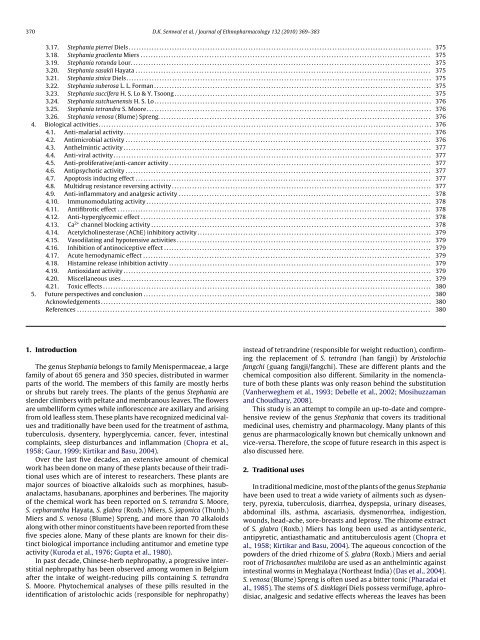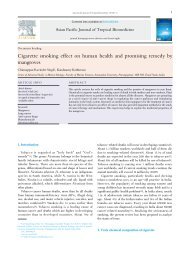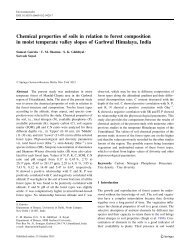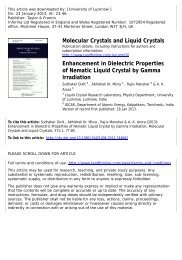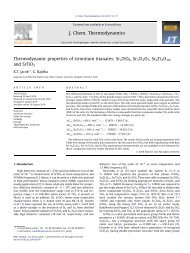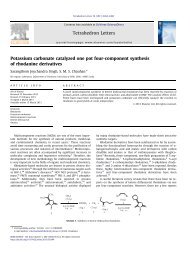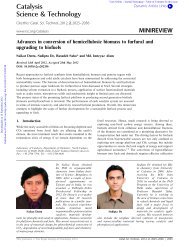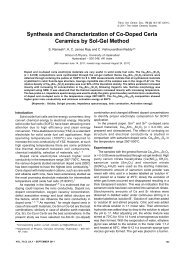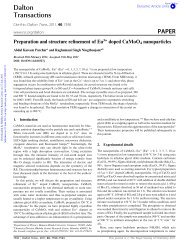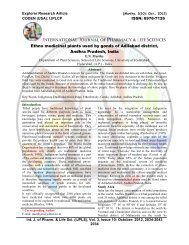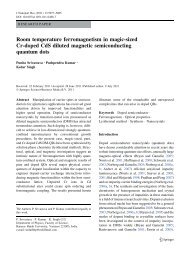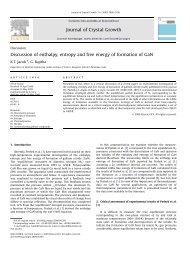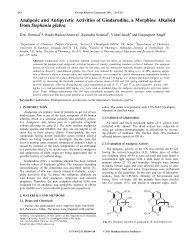The genus Stephania - Dr. DS Kothari Postdoctoral Fellowship ...
The genus Stephania - Dr. DS Kothari Postdoctoral Fellowship ...
The genus Stephania - Dr. DS Kothari Postdoctoral Fellowship ...
Create successful ePaper yourself
Turn your PDF publications into a flip-book with our unique Google optimized e-Paper software.
370 D.K. Semwal et al. / Journal of Ethnopharmacology 132 (2010) 369–383<br />
3.17. <strong>Stephania</strong> pierrei Diels ....................................................................................................................... 375<br />
3.18. <strong>Stephania</strong> gracilenta Miers .................................................................................................................. 375<br />
3.19. <strong>Stephania</strong> rotunda Lour. ..................................................................................................................... 375<br />
3.20. <strong>Stephania</strong> sasakii Hayata .................................................................................................................... 375<br />
3.21. <strong>Stephania</strong> sinica Diels........................................................................................................................ 375<br />
3.22. <strong>Stephania</strong> suberosa L. L. Forman ............................................................................................................. 375<br />
3.23. <strong>Stephania</strong> succifera H. S. Lo & Y. Tsoong ..................................................................................................... 375<br />
3.24. <strong>Stephania</strong> sutchuenensis H.S.Lo............................................................................................................. 376<br />
3.25. <strong>Stephania</strong> tetrandra S. Moore ................................................................................................................ 376<br />
3.26. <strong>Stephania</strong> venosa (Blume) Spreng. .......................................................................................................... 376<br />
4. Biological activities................................................................................................................................... 376<br />
4.1. Anti-malarial activity ......................................................................................................................... 376<br />
4.2. Antimicrobial activity ........................................................................................................................ 376<br />
4.3. Anthelmintic activity ......................................................................................................................... 377<br />
4.4. Anti-viral activity ............................................................................................................................. 377<br />
4.5. Anti-proliferative/anti-cancer activity ....................................................................................................... 377<br />
4.6. Antipsychotic activity ........................................................................................................................ 377<br />
4.7. Apoptosis inducing effect .................................................................................................................... 377<br />
4.8. Multidrug resistance reversing activity ...................................................................................................... 377<br />
4.9. Anti-inflammatory and analgesic activity ................................................................................................... 378<br />
4.10. Immunomodulating activity ................................................................................................................ 378<br />
4.11. Antifibrotic effect ........................................................................................................................... 378<br />
4.12. Anti-hyperglycemic effect .................................................................................................................. 378<br />
4.13. Ca 2+ channel blocking activity .............................................................................................................. 378<br />
4.14. Acetylcholinesterase (AChE) inhibitory activity ............................................................................................ 379<br />
4.15. Vasodilating and hypotensive activities .................................................................................................... 379<br />
4.16. Inhibition of antinociceptive effect ......................................................................................................... 379<br />
4.17. Acute hemodynamic effect ................................................................................................................. 379<br />
4.18. Histamine release inhibition activity ....................................................................................................... 379<br />
4.19. Antioxidant activity ......................................................................................................................... 379<br />
4.20. Miscellaneous uses .......................................................................................................................... 379<br />
4.21. Toxic effects ................................................................................................................................. 380<br />
5. Future perspectives and conclusion ................................................................................................................. 380<br />
Acknowledgements .................................................................................................................................. 380<br />
References ........................................................................................................................................... 380<br />
1. Introduction<br />
<strong>The</strong> <strong>genus</strong> <strong>Stephania</strong> belongs to family Menispermaceae, a large<br />
family of about 65 genera and 350 species, distributed in warmer<br />
parts of the world. <strong>The</strong> members of this family are mostly herbs<br />
or shrubs but rarely trees. <strong>The</strong> plants of the <strong>genus</strong> <strong>Stephania</strong> are<br />
slender climbers with peltate and membranous leaves. <strong>The</strong> flowers<br />
are umbelliform cymes while inflorescence are axillary and arising<br />
from old leafless stem. <strong>The</strong>se plants have recognized medicinal values<br />
and traditionally have been used for the treatment of asthma,<br />
tuberculosis, dysentery, hyperglycemia, cancer, fever, intestinal<br />
complaints, sleep disturbances and inflammation (Chopra et al.,<br />
1958; Gaur, 1999; Kirtikar and Basu, 2004).<br />
Over the last five decades, an extensive amount of chemical<br />
work has been done on many of these plants because of their traditional<br />
uses which are of interest to researchers. <strong>The</strong>se plants are<br />
major sources of bioactive alkaloids such as morphines, hasubanalactams,<br />
hasubanans, aporphines and berberines. <strong>The</strong> majority<br />
of the chemical work has been reported on S. tetrandra S. Moore,<br />
S. cepharantha Hayata, S. glabra (Roxb.) Miers, S. japonica (Thunb.)<br />
Miers and S. venosa (Blume) Spreng, and more than 70 alkaloids<br />
along with other minor constituents have been reported from these<br />
five species alone. Many of these plants are known for their distinct<br />
biological importance including antitumor and emetine type<br />
activity (Kuroda et al., 1976; Gupta et al., 1980).<br />
In past decade, Chinese-herb nephropathy, a progressive interstitial<br />
nephropathy has been observed among women in Belgium<br />
after the intake of weight-reducing pills containing S. tetrandra<br />
S. Moore. Phytochemical analyses of these pills resulted in the<br />
identification of aristolochic acids (responsible for nephropathy)<br />
instead of tetrandrine (responsible for weight reduction), confirming<br />
the replacement of S. tetrandra (han fangji) by Aristolochia<br />
fangchi (guang fangji/fangchi). <strong>The</strong>se are different plants and the<br />
chemical composition also different. Similarity in the nomenclature<br />
of both these plants was only reason behind the substitution<br />
(Vanherweghem et al., 1993; Debelle et al., 2002; Mosihuzzaman<br />
and Choudhary, 2008).<br />
This study is an attempt to compile an up-to-date and comprehensive<br />
review of the <strong>genus</strong> <strong>Stephania</strong> that covers its traditional<br />
medicinal uses, chemistry and pharmacology. Many plants of this<br />
<strong>genus</strong> are pharmacologically known but chemically unknown and<br />
vice-versa. <strong>The</strong>refore, the scope of future research in this aspect is<br />
also discussed here.<br />
2. Traditional uses<br />
In traditional medicine, most of the plants of the <strong>genus</strong> <strong>Stephania</strong><br />
have been used to treat a wide variety of ailments such as dysentery,<br />
pyrexia, tuberculosis, diarrhea, dyspepsia, urinary diseases,<br />
abdominal ills, asthma, ascariasis, dysmenorrhea, indigestion,<br />
wounds, head-ache, sore-breasts and leprosy. <strong>The</strong> rhizome extract<br />
of S. glabra (Roxb.) Miers has long been used as antidysenteric,<br />
antipyretic, antiasthamatic and antituberculosis agent (Chopra et<br />
al., 1958; Kirtikar and Basu, 2004). <strong>The</strong> aqueous concoction of the<br />
powders of the dried rhizome of S. glabra (Roxb.) Miers and aerial<br />
root of Trichosanthes multiloba are used as an anthelmintic against<br />
intestinal worms in Meghalaya (Northeast India) (Das et al., 2004).<br />
S. venosa (Blume) Spreng is often used as a bitter tonic (Pharadai et<br />
al., 1985). <strong>The</strong> stems of S. dinklagei Diels possess vermifuge, aphrodisiac,<br />
analgesic and sedative effects whereas the leaves has been


